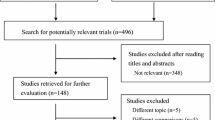Abstract
Purpose
Oral and topical sucralfate is regularly used in ulcers of gastrointestinal tract, vaginal and perianal excoriations, and radiation burns. This study was designed to determine whether there was any advantage of topical application of sucralfate in reducing postoperative pain and promoting wound healing after open hemorrhoidectomy in patients with Grades III or IV hemorrhoids.
Methods
A total of 116 patients were randomly assigned to receive sucralfate cream (sucralfate group) or placebo cream (control group) applied to the surgical site. Weekly pain score was evaluated by using Visual Analog Scale. The amount of analgesic tablets consumed in each week also was assessed. At the end of four weeks, two independent surgeons assessed the wound healing.
Results
There was no significant difference in age, gender distribution, and number of excised hemorrhoid piles between the two groups. Patients in the topical sucralfate group experienced significantly less pain at Day 7 (Visual Analog Scale ± standard error of the mean, 3.7 ± 0.3 vs. 6.1 ± 0.7; P < 0.002) and at Day 14 (1.6 ± 0.2 vs. 3.1 ± 0.6; P < 0.01). Likewise patients who received sucralfate cream used less analgesic tablets compared with the placebo group. In the sucralfate group, the overall wound healing ranked significantly better than in controls (P < 0.02).
Conclusions
Topical sucralfate significantly reduces pain at Days 7 and 14 after hemorrhoidectomy and promotes faster wound healing compared with that of a placebo.

Similar content being viewed by others
References
Davies J, Duffy D, Boyt N, Aghahoseini A, Alexander D, Leveson S. Botulinum toxin (botox) reduces pain after hemorrhoidectomy: results of a double-blind, randomized study. Dis Colon Rectum 2003;46:1097–102.
Al-Mulhim AS, Ali AM, Al-Masuod N, Alwahidi A. Posthemorrhoidectomy pain. A randomized controlled trial. Saudi Med J 2006;27:1538–41.
Pattana-Arun J, Sooriprasoet N, Sahakijrungruang C, Tantiphlachiva K, Rojanasakul A. Closed vs. ligasure hemorrhoidectomy: a prospective, randomized clinical trial. J Med Assoc Thai 2006;89:453–8.
Chung CC, Cheung HY, Chan ES, Kwok SY, Li MK. Stapled hemorrhoidopexy vs. Harmonic scalpel hemorrhoidectomy: a randomized trial. Dis Colon Rectum 2005;48:1213–9.
Cheetham MJ, Philips RK. Evidence-based practice in haemorrhoidectomy. Colorectal Dis 2001;3:126–34.
Rees WD. Mechanisms of gastroduodenal protection by sucralfate. Am J Med 1991;91:58S–63S.
Naslund I. Sucralfat ointment in treatment of perianal skin irritation. Dis Colon Rectum 1988;31:578–9.
Tryba M, Mantey-Stiers F. Antibacterial activity of sucralfate in human gastric juice. Am J Med 1987;83:125–7.
Folkman J, Szabo S, Shing Y. Sucralfate affinity for fibroblast growth factor. J Cell Biol 1990;111:223a.
Gul YA, Prasannan S, Jabar FM, Shaker AR, Moissinac K. Pharmacotherapy for chronic hemorrhagic radiation proctitis. World J Surg 2002;26:1499–502.
Banati A, Chowdhury SR, Mazumder S. Topical use of sucralfate cream in second- and third-degree burns. Burns 2001;27:465–9.
Lyon CC, Stapleton M, Smith AJ, Griffiths CE, Beck MH. Topical sucralfate in the management of peristomal skin disease: an open study. Clin Exp Dermatol 2000;25:584–8.
Henriksson R, Franzen L, Edbom C, Littbrand B. Sucralfate: prophylaxis of mucosal damage during cancer therapy. Scand J Gastroenterol Suppl 1995;210:45–7.
Nicholson TJ, Armstrong D. Topical metronidazole (10 percent) decreases posthemorrhoidectomy pain and improves healing. Dis Colon Rectum 2004;47:711–6.
La Torre F, Nicolai AP. Clinical use of micronized purified flavonoid fraction for treatment of symptoms after hemorrhoidectomy: results of a randomized, controlled, clinical trial. Dis Colon Rectum 2004;47:704–10.
Balfour L, Stojkovic SG, Botterill ID, Burke DA, Finan PJ, Sagar PM. A randomized, double-blind trial of the effect of metronidazole on pain after closed hemorrhoidectomy. Dis Colon Rectum 2002;45:1186–90.
Burch RM, McMillan BA. Sucralfate induces proliferation of dermal fibroblasts and keratinocytes in culture and granulation tissue formation in full-thickness skin wounds. Agents Actions 1991;34:229–31.
Konturek SJ, Brzozowski T, Majka J, et al. Role of nitric oxide and prostaglandins in sucralfate-induced gastroprotection. Eur J Pharmacol 1992;211:277–9.
Tytgat GN. Future clinical development of sucralfate. In: Hollander D, Tytgat GN, eds. Sucralfate: from basic science to the bedside. New York: Springer, 1995:339–49.
Author information
Authors and Affiliations
Corresponding author
Additional information
Reprints are not available.
About this article
Cite this article
Gupta, P.J., Heda, P.S., Kalaskar, S. et al. Topical Sucralfate Decreases Pain After Hemorrhoidectomy and Improves Healing: A Randomized, Blinded, Controlled Study. Dis Colon Rectum 51, 231–234 (2008). https://doi.org/10.1007/s10350-007-9092-4
Received:
Revised:
Accepted:
Published:
Issue Date:
DOI: https://doi.org/10.1007/s10350-007-9092-4




